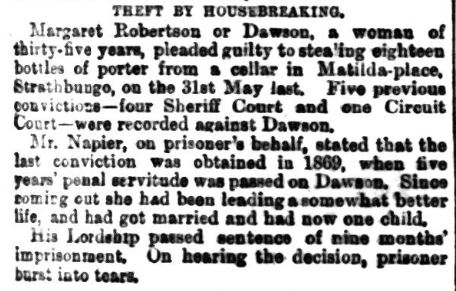Margaret Robertson appeared in court in August 1881 for the crime of stealing 18 bottles of porter from a cellar in Matilda Place, Strathbungo. As reported in the Glasgow Evening Citizen, she had several previous convictions but she had apparently been straight for several years, had married and had a child. Nonetheless she received nine months imprisonment for her crime .

Glasgow Evening Citizen, 16 August 1881. Credit: BNA
Matilda Place is the tenement on the north side of Nithsdale Road, and given my previous story about Robert Adam the grocer selling beer from the shop in the rotunda (now the New Anand), one might surmise it was his cellar she broke into.
In the 1880s the Police came up with a new technology for keeping track of criminals, the mug shot. Margaret’s picture was taken when in HM Perth and was published by Aberdeenshire Archives for an exhibition in 2019 .
As a reflection on how society treated different classes, James Nicol Fleming, a director of the City of Glasgow Bank, was convicted for “complicity in the notorious bank frauds of 1878”, being found guilty of “falsehood, fraud and wilful imposition, as also fabrication and falsification”. The failure of the bank was catastrophic for Glasgow finance, and ruined many upstanding Glasgow citizens who as shareholders were held wholly liable for the debts, which amounted to £6m (perhaps £500m now). One such shareholder, Jane Fenwick, lived in Moray Place.
According to one account, the directors were recklessly lending to themselves. When the bank collapsed, unlike the other directors of the bank, Fleming did a runner He turned up in Spain and the US before returning to face justice .
Fleming got eight months, less than Robertson. I don’t think 18 bottles of porter and £6m are quite equivalent.

James Nicol Fleming, a director of the City of Glasgow Bank, convicted of fraud in relation to the collapse of the bank. Credit: Aberdeen Archives
References
{3557955:Q3H3JNU6};{3557955:KGUDBPXR};{3557955:8X8QWXPT}
vancouver
asc
0
3570
%7B%22status%22%3A%22success%22%2C%22updateneeded%22%3Afalse%2C%22instance%22%3A%22zotpress-6e36306d18e3b909c0f26e1a8ccbd412%22%2C%22meta%22%3A%7B%22request_last%22%3A0%2C%22request_next%22%3A0%2C%22used_cache%22%3Atrue%7D%2C%22data%22%3A%5B%7B%22key%22%3A%228X8QWXPT%22%2C%22library%22%3A%7B%22id%22%3A3557955%7D%2C%22meta%22%3A%7B%22numChildren%22%3A1%7D%2C%22bib%22%3A%22%3Cdiv%20class%3D%5C%22csl-bib-body%5C%22%20style%3D%5C%22line-height%3A%201.35%3B%20%5C%22%3E%5Cn%20%20%3Cdiv%20class%3D%5C%22csl-entry%5C%22%20style%3D%5C%22clear%3A%20left%3B%20%5C%22%3E%5Cn%20%20%20%20%3Cdiv%20class%3D%5C%22csl-left-margin%5C%22%20style%3D%5C%22float%3A%20left%3B%20padding-right%3A%200.5em%3B%20text-align%3A%20right%3B%20width%3A%201em%3B%5C%22%3E1.%3C%5C%2Fdiv%3E%3Cdiv%20class%3D%5C%22csl-right-inline%5C%22%20style%3D%5C%22margin%3A%200%20.4em%200%201.5em%3B%5C%22%3EBiographies%20%7C%20James%20Nicol%20FLEMING%20%28%232728%29%20-%20The%20Cobbold%20Family%20History%20Trust%20%5BInternet%5D.%20%5Bcited%202022%20Jun%2010%5D.%20Available%20from%3A%20%3Ca%20href%3D%27https%3A%5C%2F%5C%2Ffamily-tree.cobboldfht.com%5C%2Fpeople%5C%2Fview%5C%2F2728%27%3Ehttps%3A%5C%2F%5C%2Ffamily-tree.cobboldfht.com%5C%2Fpeople%5C%2Fview%5C%2F2728%3C%5C%2Fa%3E%3C%5C%2Fdiv%3E%5Cn%20%20%3C%5C%2Fdiv%3E%5Cn%3C%5C%2Fdiv%3E%22%2C%22data%22%3A%7B%22itemType%22%3A%22webpage%22%2C%22title%22%3A%22Biographies%20%7C%20James%20Nicol%20FLEMING%20%28%232728%29%20-%20The%20Cobbold%20Family%20History%20Trust%22%2C%22creators%22%3A%5B%5D%2C%22abstractNote%22%3A%22%22%2C%22date%22%3A%22%22%2C%22url%22%3A%22https%3A%5C%2F%5C%2Ffamily-tree.cobboldfht.com%5C%2Fpeople%5C%2Fview%5C%2F2728%22%2C%22language%22%3A%22%22%2C%22collections%22%3A%5B%22CAR6MXPM%22%5D%2C%22dateModified%22%3A%222022-06-10T10%3A35%3A58Z%22%7D%7D%2C%7B%22key%22%3A%22KGUDBPXR%22%2C%22library%22%3A%7B%22id%22%3A3557955%7D%2C%22meta%22%3A%7B%22parsedDate%22%3A%222019-02-12%22%2C%22numChildren%22%3A1%7D%2C%22bib%22%3A%22%3Cdiv%20class%3D%5C%22csl-bib-body%5C%22%20style%3D%5C%22line-height%3A%201.35%3B%20%5C%22%3E%5Cn%20%20%3Cdiv%20class%3D%5C%22csl-entry%5C%22%20style%3D%5C%22clear%3A%20left%3B%20%5C%22%3E%5Cn%20%20%20%20%3Cdiv%20class%3D%5C%22csl-left-margin%5C%22%20style%3D%5C%22float%3A%20left%3B%20padding-right%3A%200.5em%3B%20text-align%3A%20right%3B%20width%3A%201em%3B%5C%22%3E1.%3C%5C%2Fdiv%3E%3Cdiv%20class%3D%5C%22csl-right-inline%5C%22%20style%3D%5C%22margin%3A%200%20.4em%200%201.5em%3B%5C%22%3EMugshots%20of%20Scotland%26%23x2019%3Bs%20Victorian%20criminals%20to%20go%20on%20show.%20BBC%20News%20%5BInternet%5D.%202019%20Feb%2012%20%5Bcited%202022%20Jun%209%5D%3B%20Available%20from%3A%20%3Ca%20href%3D%27https%3A%5C%2F%5C%2Fwww.bbc.com%5C%2Fnews%5C%2Fuk-scotland-north-east-orkney-shetland-47211731%27%3Ehttps%3A%5C%2F%5C%2Fwww.bbc.com%5C%2Fnews%5C%2Fuk-scotland-north-east-orkney-shetland-47211731%3C%5C%2Fa%3E%3C%5C%2Fdiv%3E%5Cn%20%20%3C%5C%2Fdiv%3E%5Cn%3C%5C%2Fdiv%3E%22%2C%22data%22%3A%7B%22itemType%22%3A%22newspaperArticle%22%2C%22title%22%3A%22Mugshots%20of%20Scotland%27s%20Victorian%20criminals%20to%20go%20on%20show%22%2C%22creators%22%3A%5B%5D%2C%22abstractNote%22%3A%22A%20collection%20of%20pictures%20of%20criminals%20jailed%20during%20the%201870s%20and%2080s%20is%20to%20go%20on%20show%20in%20Aberdeen.%22%2C%22date%22%3A%222019-02-12%22%2C%22section%22%3A%22NE%20Scotland%2C%20Orkney%20%26%20Shetland%22%2C%22language%22%3A%22en-GB%22%2C%22ISSN%22%3A%22%22%2C%22url%22%3A%22https%3A%5C%2F%5C%2Fwww.bbc.com%5C%2Fnews%5C%2Fuk-scotland-north-east-orkney-shetland-47211731%22%2C%22collections%22%3A%5B%22CAR6MXPM%22%5D%2C%22dateModified%22%3A%222022-06-09T20%3A26%3A28Z%22%7D%7D%2C%7B%22key%22%3A%22Q3H3JNU6%22%2C%22library%22%3A%7B%22id%22%3A3557955%7D%2C%22meta%22%3A%7B%22parsedDate%22%3A%221881-08-16%22%2C%22numChildren%22%3A1%7D%2C%22bib%22%3A%22%3Cdiv%20class%3D%5C%22csl-bib-body%5C%22%20style%3D%5C%22line-height%3A%201.35%3B%20%5C%22%3E%5Cn%20%20%3Cdiv%20class%3D%5C%22csl-entry%5C%22%20style%3D%5C%22clear%3A%20left%3B%20%5C%22%3E%5Cn%20%20%20%20%3Cdiv%20class%3D%5C%22csl-left-margin%5C%22%20style%3D%5C%22float%3A%20left%3B%20padding-right%3A%200.5em%3B%20text-align%3A%20right%3B%20width%3A%201em%3B%5C%22%3E1.%3C%5C%2Fdiv%3E%3Cdiv%20class%3D%5C%22csl-right-inline%5C%22%20style%3D%5C%22margin%3A%200%20.4em%200%201.5em%3B%5C%22%3ETheft%20by%20Housebreaking.%20Glasgow%20Evening%20Citizen%20%5BInternet%5D.%201881%20Aug%2016%20%5Bcited%202022%20Jun%209%5D%3B%20Available%20from%3A%20%3Ca%20href%3D%27https%3A%5C%2F%5C%2Fwww.britishnewspaperarchive.co.uk%5C%2Fviewer%5C%2Fbl%5C%2F0001458%5C%2F18810816%5C%2F027%5C%2F0003%27%3Ehttps%3A%5C%2F%5C%2Fwww.britishnewspaperarchive.co.uk%5C%2Fviewer%5C%2Fbl%5C%2F0001458%5C%2F18810816%5C%2F027%5C%2F0003%3C%5C%2Fa%3E%3C%5C%2Fdiv%3E%5Cn%20%20%3C%5C%2Fdiv%3E%5Cn%3C%5C%2Fdiv%3E%22%2C%22data%22%3A%7B%22itemType%22%3A%22newspaperArticle%22%2C%22title%22%3A%22Theft%20by%20Housebreaking%22%2C%22creators%22%3A%5B%5D%2C%22abstractNote%22%3A%22%22%2C%22date%22%3A%2216%5C%2F08%5C%2F1881%22%2C%22section%22%3A%22%22%2C%22language%22%3A%22%22%2C%22ISSN%22%3A%22%22%2C%22url%22%3A%22https%3A%5C%2F%5C%2Fwww.britishnewspaperarchive.co.uk%5C%2Fviewer%5C%2Fbl%5C%2F0001458%5C%2F18810816%5C%2F027%5C%2F0003%22%2C%22collections%22%3A%5B%22CAR6MXPM%22%5D%2C%22dateModified%22%3A%222022-06-09T20%3A15%3A17Z%22%7D%7D%5D%7D
Like this:
Like Loading...





Recent Comments